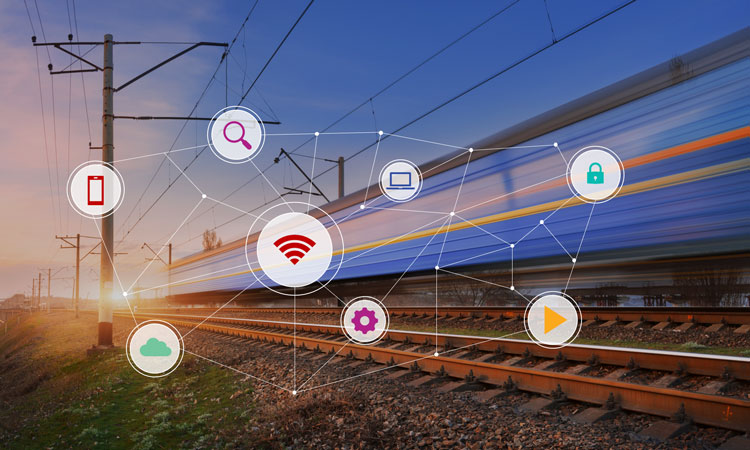Technology is evolving with the Onboard Data Centre from Nomad Digital
Posted: 13 August 2020 | Nomad Digital | No comments yet
With technology evolving all around us, Nomad Digital’s Onboard Data Centre gives the freedom and flexibility to integrate selected train systems, making it maintainable and future-proofed.


Prior to the Onboard Data Centre, traditional train technology companies such as Nomad Digital have been installing connectivity hardware on-board. An example of such technology would be the antennas installed on a train’s roof, modems installed (CCU) and writing code with the sole purpose of providing passengers with Wi-Fi. The problem is every application added to the train possesses similarities, whether this is obtaining its own hardware or discrete network – increasing the quantity of connectivity hardware on-board.
As a direct result, the train operator ends up with lots of discrete requirements and equipment which can’t communicate with one another. In effect, this can prove difficult to maintain due to the lack of space on a train, the out of service hours and just the sheer amount of hardware! The main problem is all applications are running from one programme, in effect if one application breaks and needs repaired – all applications will be offline!
Introducing the Onboard Data Centre
The Onboard Data Centre provides a virtualised platform which allows applications to run on the same hardware, equipped with remote management, monitoring and reporting services. It allows applications to work in harmony. It separates each running application – if one application fails then the rest can still run. It allows applications to run inadeptly, even when they are using shared hardware resources. Furthermore, through security, you can decide which applications can interact with other applications.
The Onboard Data Centre provided by Nomad Digital comes complete with a tool chain, allowing train operators to move applications from the shoreside to the train in a controlled way.
The benefits are apparent, first and foremost the train operator does not have to add more hardware to introduce new applications. The Onboard Data Centre provided by Nomad Digital comes complete with a tool chain, allowing train operators to move applications from the shoreside to the train in a controlled way. This increases security measures as trains are a protected asset, you don’t want a non-approved individual or team to be able to update software, unplanned.
Additionally, Nomad’s shoreside solution allows vendors to place their own software shoreside. It manages the movement of the application onto the train. The rail operator knows there is a protected means of getting the application onto the train and all trains are running the same version of the application at the same time. It also allows software companies to offer their services as they need not worry about the overheads of providing hardware. In return this opens the rail industry to more software-focused solutions.
Technology evolving
In the future, we can see more software companies being introduced to the rail industry due to their ability to deploy their software and bypass hardware. As more companies enter the fold and competition increases, the quality and variety of software (add-ons) for the train operator will only increase. Software-as-a-service will become more common, benefiting both the operator and the passenger. We could see onboard gaming solutions introduced for longer passenger train journeys or paid streaming services, delivering a new revenue within the industry. Applications need not always be customer-facing, they can benefit the staff such as, a handheld device which could feed them live data including:
- How busy the service is?
- Is the train operational/on time?
- Does a passenger need assistance?
The Onboard Data Centre has longevity and is both upgradeable and expandable, reducing the proliferation of hardware requirements. It allows train operators to customise their passenger experience and offer a tailored service.
There are a lot of shared services on the Onboard Data Centre, so data can be shared between the applications. For instance, GPS data is available on a message queue, so access can be granted to individuals who require the GPS location data, confidently knowing it’s the single source of the data and it is refreshed regularly.
Finally, it provides the environment to lower the costs of applications and allows temporary solutions to be used so operations can survey equipment over a three-month period for example. To do this in the past would have been difficult.
Final thoughts
The Onboard Data Centre has longevity and is both upgradeable and expandable, reducing the proliferation of hardware requirements. It allows train operators to customise their passenger experience and offer a tailored service. For example, a train operator can use an application running on the onboard data centre which allows customers to order food from their seat instead of having to venture to the buffet cart. In times of COVID-19 this would allow passengers to maintain their distance whilst acquiring their food. It allows train operators to adjust their applications in-line with the current climate and maintain the ‘intelligent journey’.
Acknowlegdement
Credit to Nomad’s technical expert, Stephen Lathan, for supporting on this piece.
Related topics
Big Data, Passenger Experience/Satisfaction, Technology & Software








